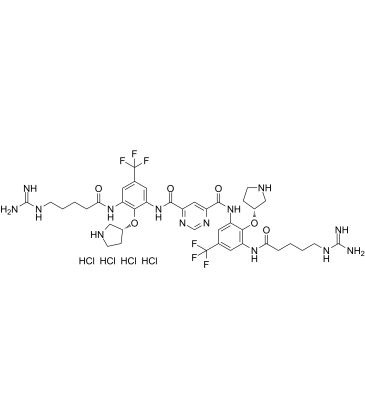Brilacidin tetrahydrochloride (Synonyms: PMX 30063 tetrahydrochloride) |
| Katalog-Nr.GC60096 |
Brilacidin-Tetrahydrochlorid (PMX 30063-Tetrahydrochlorid) ist ein antiinfektiÖses antimikrobielles Mittel mit MHK90 von 1 und 8 μg/ml fÜr grampositive Bakterien Streptococcus pneumonia und Streptococcus viridans und MHK90 von 8 und 4 μg/ml fÜr gramnegative Bakterien Haemophilus influenza und Pseudomonas aeruginosa.
Products are for research use only. Not for human use. We do not sell to patients.

Cas No.: 1224095-99-1
Sample solution is provided at 25 µL, 10mM.
Brilacidin tetrahydrochloride (PMX 30063 tetrahydrochloride) is an anti-infective antimicrobial with MIC90s of 1 and 8 μg/mL for Gram-positive bacteria Streptococcus pneumonia and Streptococcus viridans, and MIC90 of 8 and 4 μg/mL for Gram-negative bacteria Haemophilus influenza and Pseudomonas aeruginosa. Brilacidin tetrahydrochloride is a defensin mimetic antibiotic compound[1][2].
Both Staphylococcus aureus (SA) and Staphylococcus epidermidis (SE) have the lowest minimum inhibitory concentrations among the bacterial groups. The MIC90s to Brilacidin for Streptococcus pneumonia (SP), Streptococcus viridians (SV), Moraxella (MS), Haemophilus influenza (HI), Pseudomonas aeruginosa (PA), and Serratia marcescens (SM) are 4, 32, 256, 32, 16, and 128-fold higher, respectively, than SA and SE. Brilacidin has Gram-positive in vitro activity; topical Brilacidin 0.5% is minimally irritating; and Brilacidin 0.5% was equally efficacious as Vancomycin (VAN) in a methicillin-resistant S. aureus (MRSA) keratitis model when the corneal epithelium is removed. Brilacidin acts primarily on the bacterial cell membrane by depolarization. Brilacidin is more potent for Gram-positive bacteria (except SV) than Gram-negative bacteria[2].
Brilacidin demonstrates dose-dependent ocular toxicity after 7 topical instillations (every 30 min for 3 h) in the NZW rabbit ocular toxicity model. Brilacidin 1% is determined to be Mildly Irritating (23.0), Brilacidin 0.5% (6.5), and Brilacidin 0.25% (4.0) are determined to be Minimally Irritating, while Brilacidin 0.1% (2.0) and TBS (1.0) are determined to be Practically Nonirritating and 0.01% Brilacidin (0.5) is determined to be Nonirritating based on their Maximum mean total scores (MMTS) values[2].
[1]. Bruk Mensa , et al. Comparative Mechanistic Studies of Brilacidin, Daptomycin, and the Antimicrobial Peptide LL16. Antimicrob Agents Chemother. 2014 Sep;58(9):5136-45. [2]. Regis P Kowalski, et al. An Independent Evaluation of a Novel Peptide Mimetic, Brilacidin (PMX30063), for Ocular Anti-infective. J Ocul Pharmacol Ther. Jan-Feb 2016;32(1):23-7.
Average Rating: 5 (Based on Reviews and 14 reference(s) in Google Scholar.)
GLPBIO products are for RESEARCH USE ONLY. Please make sure your review or question is research based.
Required fields are marked with *




















